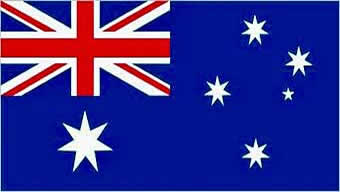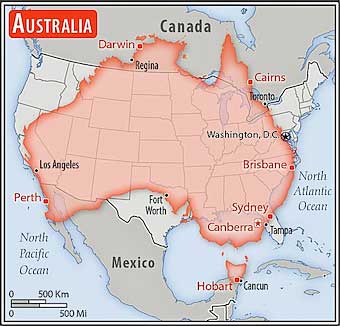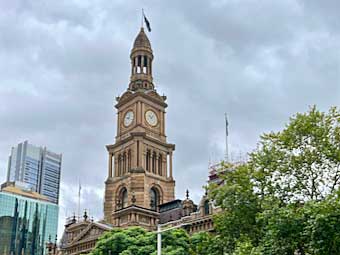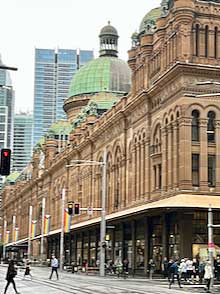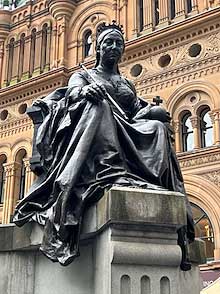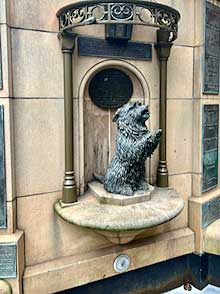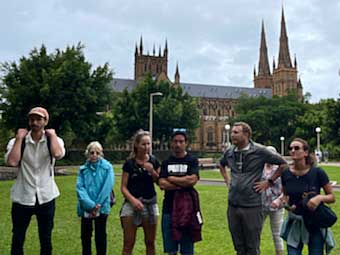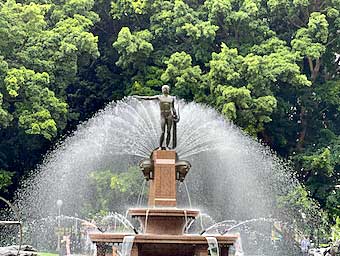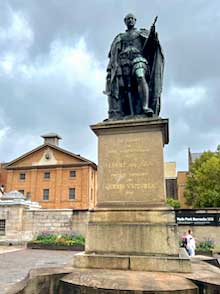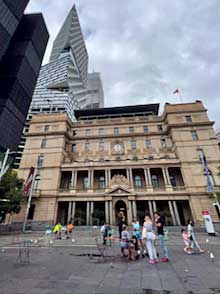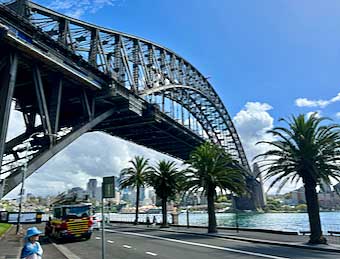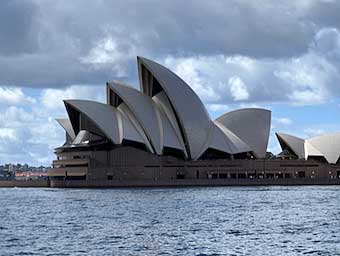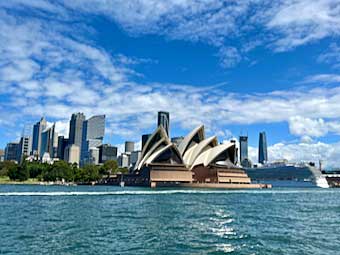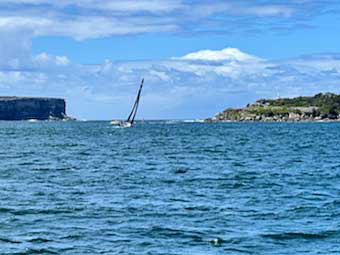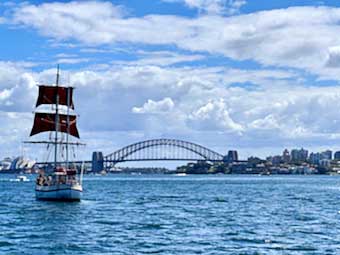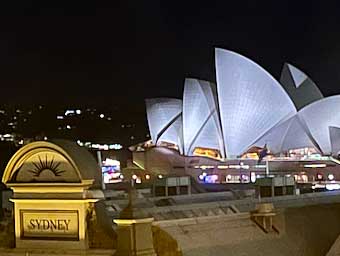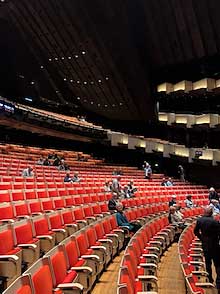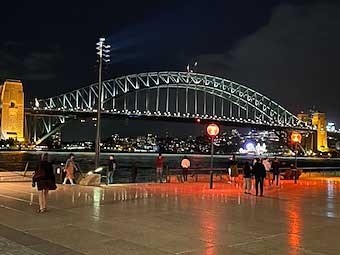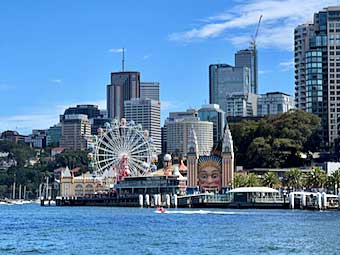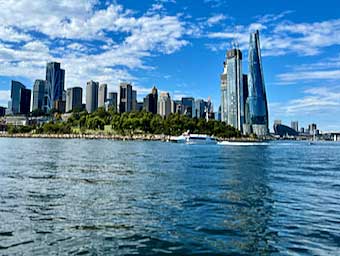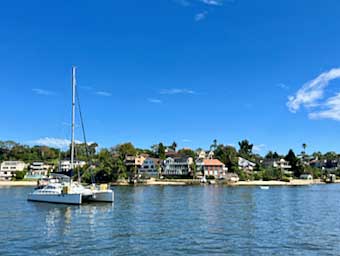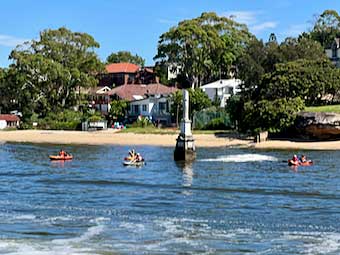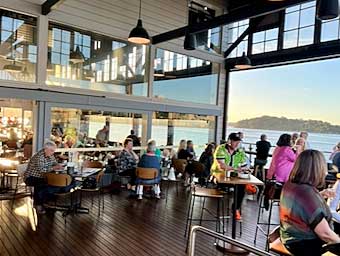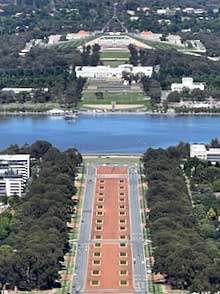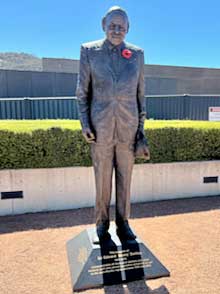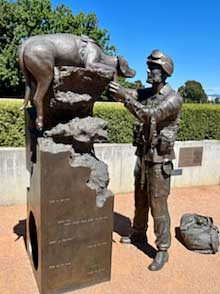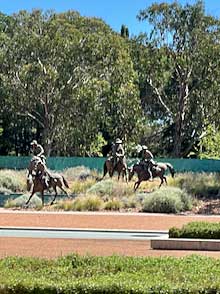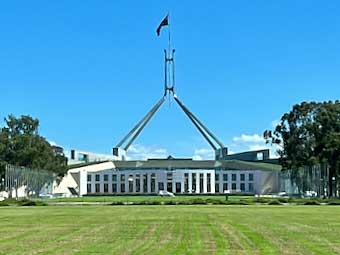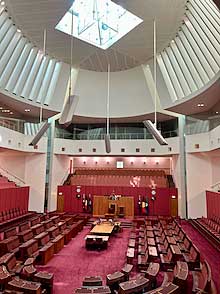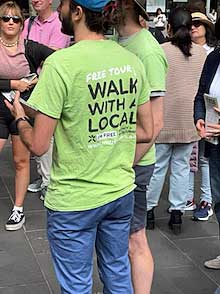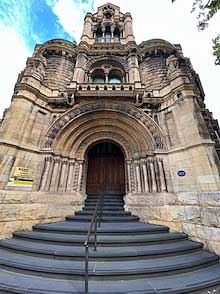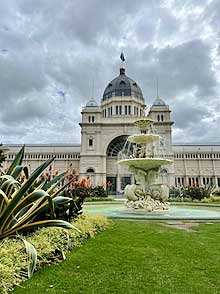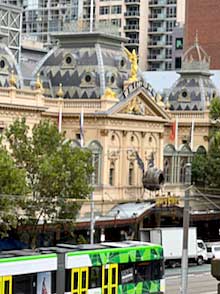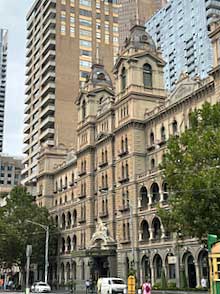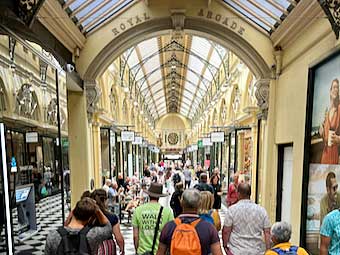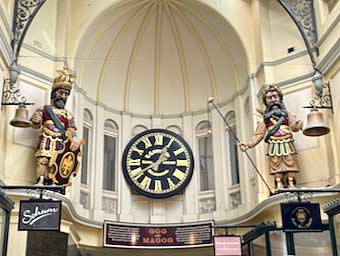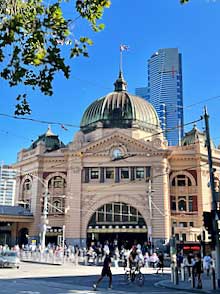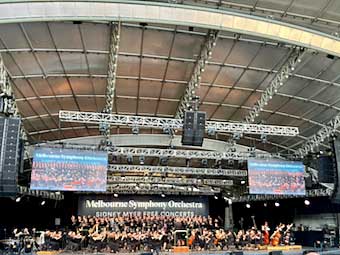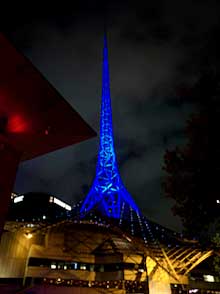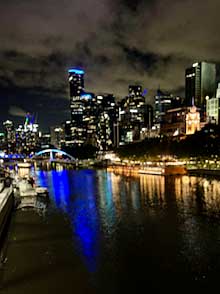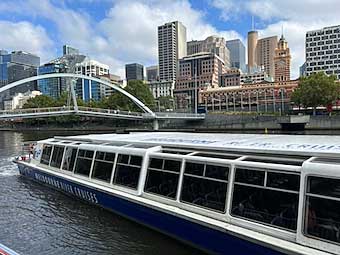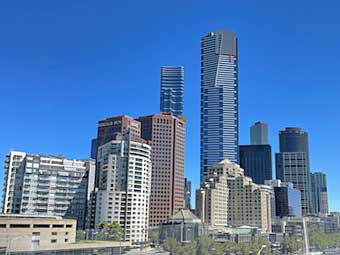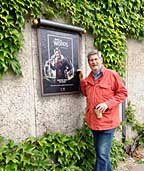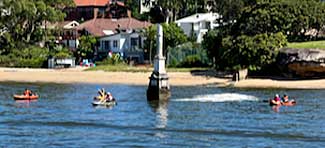 |
|
DOWN UNDER: TOURING AFOOT AND AFLOAT Australia - Sydney, Melbourne, Canberra |
|||
Story and photos by Brad Hathaway |
|||
Would you call a visit to Miami and Washington DC a tour of the United States? No, neither would I. So I can’t say our visit to Sydney and Melbourne (with a side trip to Canberra) was a tour of Australia. But it was a chance to get a taste of the land down under. It is a big place! It may be the smallest continent on Earth, but it is still the sixth largest country on the planet with about the same number of square miles as the entirety of the 48 contiguous states of the U. S.
In both major cities, we started off with walking tours conducted by guides from the “I’m Free” tour group, part of a world-wide network of free walking tour groups called the Free Tour Community. Our first guide took a group of about 30 visitors on a walk from a meeting point near the Sydney Town Hall to a park with a gorgeous view over the harbor of the famous Sydney Opera House.
Our first stop was the Sydney Town Hall where the Lord Mayor of Sydney and the city council is housed in an imposing second empire style building dating to the 1870s and 1890s. Across George Street from Town Hall is the huge Queen Victoria Building which also dates to the 1890s. It started as a market but now is the modern version of that - a shopping mall. Hanging under the skylight is “The Royal Clock” which exhibits scenes from English history every hour on the hour to the accompaniment of mechanical trumpeters.
The building’s namesake, Queen Victoria, sits in bronze before its entrance next to a less imposing but oh-so-interesting additional bronze sculpture. It is of the queen’s favorite pet, the terrier Islay who, through the miracle of modern technology, occasionally speaks to ask tourists to throw money into the wishing well at her feet.
Then it was off to Hyde Park. No, not in England. The Hyde Park in London probably got its name from the old-English word “hyd” which meant a wooden enclosure. London’s Hyde Park was once a game preserve enclosed by a fence. The one in Sydney is named for the one in London and it doesn’t have a fence. Instead, some 40 acres of green are wide open in the Sydney business district with St. Mary’s Cathedral in the background. The park features a fountain dominated by a statue of the god Apollo. The fountain is named for the man who donated the funding for it, J. F. Archibald.
Just outside the park, a statue of Queen Victoria’s consort, Prince Albert, stands in front of the Hyde Park Barracks. Our guide sketched the history of the barracks, which were designed by a convict architect named Francis Greenway. He also designed St. James’ Church across the street from the Barracks. He was transported to Australia from England in lieu of his death sentence on the charge of forgery of a financial document. It is somewhat ironic that his face was on the $10 bill when Australia converted from the pound to the dollar. Can you name another forger to be on a nation’s currency?
We stopped at the Customs House on the harbor at Circular Quay. The impressive old structure stands in stark contrast to the modern sky-scrapers that tower over it.
Enough walking. It was time to catch a ferry over that beautiful harbor. So, it was back to Circle Quay where five commuter ferry wharves serve eight routes to who knows how many destinations. We chose one to Manly on the North Harbour - the longest route out toward the ocean. This gave us a great view of the skyline of Sydney with the Opera House in the foreground and a cruise ship in port.
On the return voyage we caught sight of the opening to the Pacific Ocean and, then, as we approached downtown Sydney again, there was a vessel picturesquely sailing in front of the Sydney Harbour Bridge - what a beautiful sight!
One doesn’t visit Sydney without attending a performance in the Opera House, now does one? Well, not us! That evening, Opera Australia offered one of seven performances of the Francesco Ciléa’s Adriana Lecouvreur to be sung in Italian but with English subtitles for those of us who don’t know the lingo. It was to feature Albanian soprano Ermonela Jaho, but the locals were abuzz over the fact that Jaho had a cough serious enough to keep her from performing and a local singer had gone on to great reviews. We were to hear Natalie Aroyan in the lead role and we certainly weren’t disappointed. For one who must have had minimal rehearsal time, she not only sang the role well, her acting was perhaps the most convincing of that of anyone in the cast this night.
As we emerged from the performance, we were greeted by a view of the Sydney Harbour Bridge all lit up. Under the bridge you can see the entrance to Luna Park and its Ferris wheel.
The next day we returned to Circular Quay to catch one of the ferries headed the other direction from the one we’d taken the day before. We headed up the Parramatta River. As we sailed under the Sydney Harbour Bridge we spotted that same Luna Park that we saw lit up the night before. It is an amusement park that has been a popular attraction off and on since the 1930s. In 1979 it was closed after a fire killed seven people in one of the rides - including six children. In 1988 it was closed again over safety problems. More recently, noise complaints from the park’s neighbors have created controversy, and then, in 2020 covid shuttered it for months. Currently, it is open and operating.
The ferry continued on into Darling Harbor where we saw the modern architecture of the Sea Life Aquarium and the Australian National Maritime Museum as well as the up-scale Crown Sydney, Barangaroo. It is a twisting tower nearly 900 feet tall with 75 floors of hotel and residential units.
The ferry took us just four miles up the Parramatta from Sydney but into a different environment. As we rode on a clear and sunny afternoon we could see along the banks prosperous communities of condominiums and single family houses and some kayakers out enjoying time on the water.
On the return trip, we sighted Walsh Bay where four piers host a number of activities. Of most interest to us was the one hosting arts groups like the Sydney Dance Company, Gondwana Children’s and National Choirs and the Sydney Theatre Company which has two theaters there, Wharf 1 and Wharf 2. At the end of the pier there is a restaurant and bar for before-theater dinner or after-theater drinks.
As soon as the ferry docked, we went to the box office and found that they had a show that evening so we bought tickets. It turned out to be a delightfully up-tempo comic romp that took Jane Austen’s stories, updated them to current day, changed the setting to Sydney and also changed the genders and proclivities. While Austen wrote of Pride and Prejudice and Sense and Sensibility, Australian playwright Lewis Treston wrote Hubris and Humiliation! What a great way to close out our visit to Sydney. SIDE TRIP - CANBERRA Not all of our sight-seeing was on foot or by boat. We took a van the 153 miles (as the crow flies … closer to 180 miles by road) for a brief but fascinating visit to Australia’s capital city, Canberra. Like the USA with Washington DC and Brazil with Brazília, Australia has a capital city built from scratch. Under the constitution that established the Commonwealth of Australia in 1901, the parliament had to choose a site at least a hundred miles from Sydney. They picked a spot on the Molonglo River said to be no more than “an outback sheep station” but bearing the name Canberra, which in the aboriginal language meant “meeting place.” The new national government held an international competition for a plan for the capital city in 1912 for which 137 entries were received. Chicago architect Walter Burley Griffin, who had worked with (or for) Frank Lloyd Wright for a time, submitted the winning plan and became the Australia’s Pierre Charles L’Enfant.
Before entering the city itself, our van stopped at a lookout on Mount Ainslie, nearly a thousand feet above the city. From there we could clearly see Griffin’s master plan with a ceremonial “parade” of memorials on the near side of the river and the government complex on the far side. The lower white building is the Old Parliament House (or Provisional Parliament House as it was first known) and above that is the entrance to the modern Parliament House built into the hillside. We drove down to the memorial parade. Here are some of the memorials: - A statue by Peter Corlet of Sir Edward ’Weary’ Dunlop, one of the many Australian doctors and medical staff who, as prisoners of the Japanese during World War II, doctored their fellow prisoners. - A sculpture by Ewen Coates honoring Explosive Detection Dogs, including those who lost their lives in explosions, as well as their human handlers. - Soldiers on horseback commemorating Australia
Then it was across Lake Burley Griffin, a section of the Molonglo River that was dammed to present a wider water feature for the capital. We wanted to explore the “new” Parliament House, which was the real reason we’d travelled all this way. The building’s design was selected after another international competition. The Philadelphia firm of Mitchell/Giurgola & Thorp Architects won, and Italian-born Romaldo Giugola came to Australia to handle the project on site. Built into the Capital Hill with only a ceremonial front facing the lake and parade, the building’s most striking feature is a steel spire topped by an enormous flagpole from which flies a 20-foot by 40-foot flag. Giugola’s original design had called for a spire some 650 feet tall, but that was cut back to just 250 feet.
Australia has a bicameral legislature so we wanted to see both chambers. First it was the House of Representatives where 151 members elected to terms of up to three years sit in a chamber with a primary color of green because the lower house in London - the House of Commons - sits in a green chamber. The 76 members of the Senate, on the other hand, meet in a room primarily red like the British House of Lords.
MELBOURNE Just as in Sydney, we started our exploration of Melbourne with a three-hour walking tour from the “I’m Free” tour group. Our guide started us off walking past the Royal Melbourne Institute of Technology, a university occupying a number of interesting buildings in a downtown campus. Melbourne is home to eleven universities and twelve colleges with over 300,000 students - more than any other Australian city.
We proceeded to the Carlton Gardens, a lovely urban park in which sits the Royal Exhibition Building, built for the International Exposition of 1880-81 but used again for one in 1888 - the boom years for Melbourne. The building is now part of the Melbourne Museum. Next stop? The Eight Hour Reserve, a small adjacent park containing a monument commemorating the early activists who struck for an 8-hour day . . . actually, their demand was for “8 hours of work, 8 hours of rest and 8 hours of recreation” so the monument is topped by the numerals 888.
Two notable buildings drew my attention along Spring Street—the Princess Theatre and the Windsor Hotel. It wasn’t just that The Princess, built in 1886 in classic Second Empire style was playing the stage version of Harry Potter, as intriguing as that might be. No, it was the huge golden statue of the Greek muse of comedy and tragedy, Thalia, that stands over its cornice that caught my eye. (She’s not solid gold—merely gold leaf over copper.) Just down Spring Street is the Windsor Hotel, a grand edifice in the Second Empire style so popular during Melbourne’s boom period of the 1880s. It is the last of the grand hotels of its age still standing in Melbourne.
We walked through two arcades, the forerunners of shopping malls - covered walks that, if they weren’t covered, would constitute alleys through the middle of blocks in the commercial district. Here, though, the shops all face in toward the covered walk, not toward the streets outside the block. Most of the shops are now high-end establishments, especially so in the Royal Arcade with its clock featuring two mythological giants who ring its bells every hour on the hour. Gog and Magog have stood the test of time ever since jeweler Thomas Gaunt installed this clock here in 1892.
Thus far, all the sights had been on the North side of the Yara River that runs through the city. So now it was time to head for the Princess Bridge, the main thoroughfare over the river, only one of a dozen bridges for cars, pedestrians and trams. On its north end is Flinders Street Railway Station, from, to or through which all the trains of the city’s extensive metropolitan network and regional lines run. It was built in 1856. On the south end of the bridge is the much newer (1970s and 80s) Arts Centre Melbourne, with a 2,466-seat concert hall, a 2,079-seat opera, ballet and major musicals theater, as well as an 884-seat theater for plays and smaller dance companies. Towering over the theatre building is a steel spire and mast reaching a height of over 550 feet.
Here we left our walking guide because we had tickets to a concert by the Melbourne Symphony Orchestra. However, as in Sydney, we tipped our guide generously at the end of the tour knowing that’s how they manage to stay in business offering free tours. We certainly will seek out a tour group affiliated with the Free Tour Community when planning visits to other cities. They have a website at freetourcommunity.com which lists over 80 cities in over 40 countries. The symphony concert was a free event for the citizens of Melbourne put on by the Melbourne Symphony Orchestra (MSO) every year in the Sydney Myer Music Bowl, an outdoor arena that can seat 12,000 on a lawn facing its covered but open bowl where an additional 2,150 patrons can sit. I can’t vouch for an actual count of the audience on this night, but it sure seemed to be close to capacity as the MSO, under conductor Benjamin Northey, put on quite a show. First up was Prokofiev’s Piano Concerto Number 3 dazzlingly played by Hannah Shin. Then the orchestra was joined by the MSO Chorus and soloists for the super-dramatic Carmina Burana by Carl Orff.
Night had fallen by the time we left the concert and we saw the Arts Center spire illuminated in blue over its golden mesh base, and then as we walked back across the bridge we enjoyed the view of the river with the Southbank Pedestrian Bridge in front of the city skyline.
The next morning we returned to the river near that same Southbank Pedestrian Bridge to catch a cruise down the Yara in order to see the skyline of this modern city. After all, Melbourne has more skyscrapers than any other city in Australia - 74 at last count.
On the river’s south bank, joining the cultural facilities like theaters and museums, are many office and residential towers. This includes the tallest building in Australia, a 1,040 foot tall (100 floors) tower called Australia 108. It is the tower on the left in the center of this photo (upper right) - the tower to its right, at only 975 feet, appears taller because it is closer.
As a first experience in Australia, our visit was superb but of course all too brief and incomplete. We sampled the south eastern states of New South Wales and Victoria but there’s so much more. There’s Queensland with Brisbane and the great barrier reef. There’s the Northern Territory with Darwin, Western Australia with Perth and South Australia with Adelaide to discover, not to mention Hobart in Tasmania. Something tells me we’ll be back. ABOUT THE AUTHOR
|
